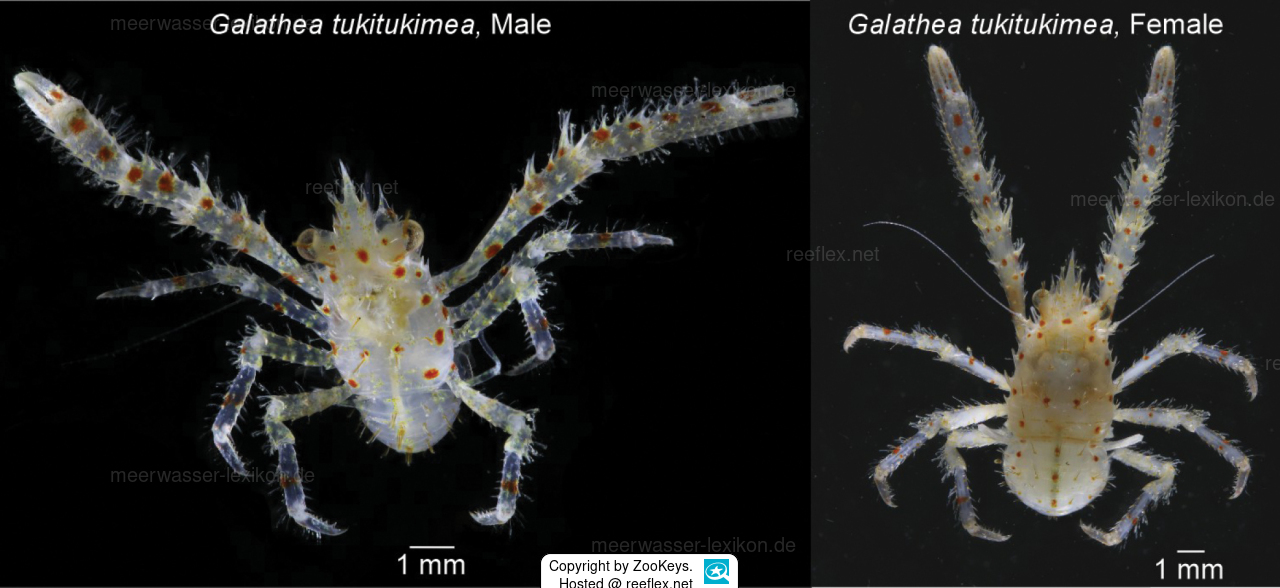Info
Easter Island is a volcanic island in the southeastern Pacific Ocean that belongs politically to Chile and geographically to Polynesia.
At greater depths that cannot be reached by divers with regular diving equipment, a jumping crab was discovered whose occurrence in this region was previously unknown.
This find is therefore the first evidence of the genus in this region of the Pacific and in Chilean territory.
The small jumping crab lives in association with the sea urchin Stereocidaris nascaensis Allison, Durham & Mintz, 1967, which provides a very practical means of transport to new areas with fresh food.
Whether the type of coexistence is symbiosis, commensalism, or (less likely) parasitism is also not discussed.
However, scientists note that this potentially mimicry-based coexistence is unusual among jumping crabs, warranting further investigation.
This sea urchin is white with a reddish coloration at the base of its spines and was found on rocky bottoms, and on the Pukao Seamounts, the substrate was covered with red crustose algae at a depth of 348 meters.
Unfortunately, the publication does not provide any information about the biology, diet, or water temperatures.
We determined and stored the water temperature using Ocean Data View from the Alfred Wegener Institute - Helmholtz Centre for Polar and Marine Research.
Coloration.
The dorsal surface of the cephalothorax, chelipeds, and pereiopods are white with yellow-orange spots bearing red dots.
The dorsal areas are covered with iridescent hairs.
The sternit is also white.
Distribution.
Chilean Exclusive Economic Zone; Rapa Nui Multiple-Use Coastal Marine Protected Area (AMCP-MU Rapa Nui); on the Pukao Seamounts; Motu Motiro Hiva Marine Park (MMH Park); around Motu Motiro Hiva Island (Salas and Gómez Island), discovered at depths of 348-407 meters.Etymology.
The specific epithet tukitukimea derives from the Rapa Nui words tuki tuki mea, meaning “red dots”, in reference to the vivid reddish spots on the carapace and pereiopods. The name was proposed by Serafina Moulton Tepano, a Rapa Nui artist who accompanied the FKt240224 expedition. It is treated as a noun in apposition.
Etymology:
The species name “tukitukimea” is derived from the Rapa Nui words “tuki tuki mea,” meaning “red dots,” in reference to the vivid reddish spots on the carapace and pereopods.
The name was suggested by Serafina Moulton Tepano, a Rapa Nui artist who accompanied the FKt240224 expedition.
Scientifiv Reference
Gallardo Salamanca MdelosÁngeles, Asorey C, Macpherson E (2025) A new species of Galathea (Decapoda, Galatheidae) from the seamounts of the Easter Island area (Southeast Pacific Ocean Ridge) associated with a sea urchin.
ZooKeys 1248: 111-123. https://doi.org/10.3897/zookeys.1248.159542
This is an open access article distributed under the terms of the CC0 Public Domain Dedication.
At greater depths that cannot be reached by divers with regular diving equipment, a jumping crab was discovered whose occurrence in this region was previously unknown.
This find is therefore the first evidence of the genus in this region of the Pacific and in Chilean territory.
The small jumping crab lives in association with the sea urchin Stereocidaris nascaensis Allison, Durham & Mintz, 1967, which provides a very practical means of transport to new areas with fresh food.
Whether the type of coexistence is symbiosis, commensalism, or (less likely) parasitism is also not discussed.
However, scientists note that this potentially mimicry-based coexistence is unusual among jumping crabs, warranting further investigation.
This sea urchin is white with a reddish coloration at the base of its spines and was found on rocky bottoms, and on the Pukao Seamounts, the substrate was covered with red crustose algae at a depth of 348 meters.
Unfortunately, the publication does not provide any information about the biology, diet, or water temperatures.
We determined and stored the water temperature using Ocean Data View from the Alfred Wegener Institute - Helmholtz Centre for Polar and Marine Research.
Coloration.
The dorsal surface of the cephalothorax, chelipeds, and pereiopods are white with yellow-orange spots bearing red dots.
The dorsal areas are covered with iridescent hairs.
The sternit is also white.
Distribution.
Chilean Exclusive Economic Zone; Rapa Nui Multiple-Use Coastal Marine Protected Area (AMCP-MU Rapa Nui); on the Pukao Seamounts; Motu Motiro Hiva Marine Park (MMH Park); around Motu Motiro Hiva Island (Salas and Gómez Island), discovered at depths of 348-407 meters.Etymology.
The specific epithet tukitukimea derives from the Rapa Nui words tuki tuki mea, meaning “red dots”, in reference to the vivid reddish spots on the carapace and pereiopods. The name was proposed by Serafina Moulton Tepano, a Rapa Nui artist who accompanied the FKt240224 expedition. It is treated as a noun in apposition.
Etymology:
The species name “tukitukimea” is derived from the Rapa Nui words “tuki tuki mea,” meaning “red dots,” in reference to the vivid reddish spots on the carapace and pereopods.
The name was suggested by Serafina Moulton Tepano, a Rapa Nui artist who accompanied the FKt240224 expedition.
Scientifiv Reference
Gallardo Salamanca MdelosÁngeles, Asorey C, Macpherson E (2025) A new species of Galathea (Decapoda, Galatheidae) from the seamounts of the Easter Island area (Southeast Pacific Ocean Ridge) associated with a sea urchin.
ZooKeys 1248: 111-123. https://doi.org/10.3897/zookeys.1248.159542
This is an open access article distributed under the terms of the CC0 Public Domain Dedication.







 ZooKeys
ZooKeys














